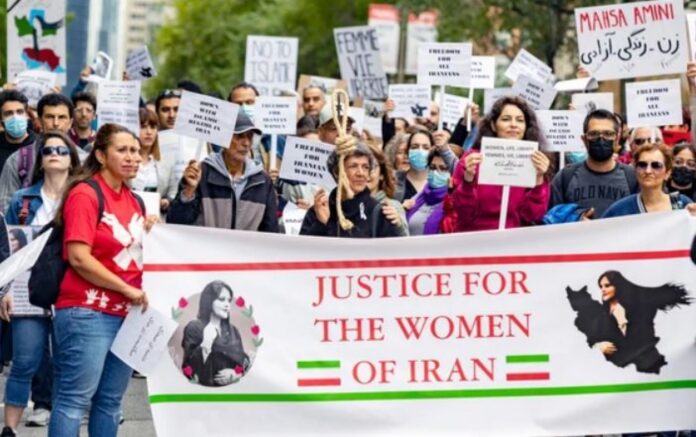Iranian women are in the streets demanding justice for Mahsa Amini and an end to the suppression of women in Iran. Mahsa Amini was allegedly killed by the “Guidance patrol” – who apprehend women if they are believed to be improperly dressed in public. As the whole world mourns the tragic death of Mahsa Amini by marching in solidarity with the Iranian protesters, the government in Iran is ruthlessly crushing them. Since the Islamic revolution in Iran, women have been subjected to social and political barriers. Under Iranian law, women are forced to fully cover their bodies from head to toe in public places. Amid the ongoing crisis in Iran, the protestors cry the slogans of “Zan, Zindagi, Azadi” (Woman, Life, Freedom), demanding equal rights for women.
In Iran, religious laws were enforced in 1979, when Islamic revolutionists overthrew the Shah of Iran. The clergy government adopted strict social codes for women while restricting their social and political life. In Iran, women are forced to wear closed types of clothes while not showing their body parts in public areas. If anyone is found violating the dress code, she is liable to face punishment. Mahsa Amini was apprehended from a railway station in Tehran by Iran’s morality police for her alleged inappropriate dress in public. She died after spending three days in police custody. Her family members alleged that she died due to torture during custody. The killing of Mahsa Amini has drawn anger and unrest among Iranians as thousands of Iranians came out in protest.
Instead of showing sympathy towards the protesters, the Iranian government is ruthlessly trying to crush the movement. The security forces and the Basij (religious militia) have tried to suppress the protesters. The Iranian Supreme Leader Ayatollah Khamenei has also endorsed the actions of security forces while calling the protests a US-Israeli plot. Iranian President Ebrahim Raisi has blamed the West for inciting violence in Iran. According to the reports, as of Wednesday, 154 protesters have been killed by the Iranian security forces. The political structure in Iran is lopsided, with no legitimate and effective opposition. The strings of any government are controlled by the clerical leadership under Ayatollah Khamenei. People and media refrain from targeting the country’s leadership openly as they fear persecution.
Iran is a classic example of gender inequality, where women are denied their fundamental rights. However, many believe that the current generation of Iran is different from previous ones. The modern generation of Iran wants to choose what to wear and what not to wear. The young generation of Iran is more politically and socially aware and thus wants more social and political freedom. It is not possible to effectively run a country by marginalizing half of its population, thus Iran needs to ensure active and effective representation of women.
Mahsa Amini’s death has incited an outcry from human rights activists both domestically and internationally. In Tehran, thousands of female school and college students took off their mandatory headscarves in support of women’s rights and fundamental freedom. Iranian diaspora along with the international community has collectively endorsed the women’s rights activists in Iran. The current wave of protests has transcended the ethnic and religious lines of Iran. Amini’s death has also been criticized widely by celebrities, politicians, and members of civil society. Although the ongoing protests are triggered by the death of Mahsa Amini, people are taking out their frustration against the decade-long unethical treatment of women, failure of economic policies, corruption, and social restrictions on women.
The demonstrators are demanding the removal of social restrictions against women. First and foremost, the protestors are demanding that moral police must be held accountable for the death of Mahsa Amini. Second, the protesters want to eliminate laws that make hijab mandatory for females. Women in Iran are demanding that they should be given the right to choose to wear hijabs. Third, the women of Iran are demanding freedom, equal rights, and political representation.
Iran is a classic example of gender inequality, where women are denied their fundamental rights. However, many believe that the current generation of Iran is different from previous ones. The modern generation of Iran wants to choose what to wear and what not to wear. The young generation of Iran is more politically and socially aware and thus wants more social and political freedom. It is not possible to effectively run a country by marginalizing half of its population, thus Iran needs to ensure active and effective representation of women. Therefore, Zan, Zindagi, Azadi should be protected in Iran for the sake of the well-being of both the women and the country.























